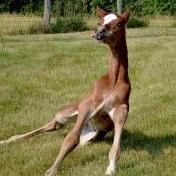-
Content Count
1,044 -
Joined
-
Last visited
About TomE
- Currently Viewing Forums Index
-
Rank
Leatherworker.net Regular
Contact Methods
-
Website URL
www.maefieldfarm.com
Profile Information
-
Location
west of Saint Louis
-
Interests
horses, fixing the stuff they break
LW Info
-
Leatherwork Specialty
making and repairing tack
-
Interested in learning about
construction methods, using and sharpening tools
Recent Profile Visitors
The recent visitors block is disabled and is not being shown to other users.
-
Thank you, Ron. The round nose strap for reins is a separate piece that can slide across the nose. There is an additional, fixed noseband behind the halter square to support the halter on the nose. The throatlatch round is 7 oz leather wrapped around a filler strip of 7 oz leather, sewn, trimmed, and shaped in a rein rounder. It is described in the PDF linked to this post:
-
Thanks, @DieselTech. I don't use a stitch groover. I mark the stitch lines with a divider for machine sewing, and use pricking irons for hand sewing. I tap the stitch lines on the backside to flatten the blowout from the machine needle. When repairing tack it's typically the leather that breaks, usually where it wraps around hardware, not the thread. The only thread I've seen fail is old linen thread that rotted.
-
Halter or bridle? This training halter has an additional noseband that attaches to reins, functioning as a bitless bridle. The flexible noseband is made from woven rope wrapped in soft leather. A browband was added to secure the crown. Made from Hermann Oak bridle leather, nappa leather for the padding, stainless steel hardware from Beiler's Manufacturing and Supply, and Equus rubber grips on the reins from Abbey England.
-
I haven't had that outcome with Effax Leder Balsam, but it does happen with Blackrock Leather N' Rich conditioner. I buff repeatedly with a soft cloth, and finish with a soft brush for polishing shoes. Applying some heat with a hair dryer might improve penetration into the leather so there's less buildup on the surface.
-
That's a good looking belt. I would use an edger on both sides, flesh and grain, for a more finished look. You will learn whether or not your edger is sharp when you work on the flesh side. There are lots of recipes for finishing edges, depending on thickness, type of leather, and how to item will be used. Here's some ideas
-
Regarding paranormal phenomena related to cows, my brother-in-law is a retired veterinarian who used to do a lot of work at dairies. When they were implanting embryos in cows he would hold his vet tech's wedding ring on a thread over the petri dish containing the embryo. They would predict the sex of the embryo based on the direction that the ring rotated. Had to be his tech's ring to get an accurate reading. Probably another case of cow magnetism. He is a bit of a magician and story teller, which his clients enjoyed.
-
Good looking bunch of straps. Hard to choose a favorite. I like your unique artwork.
-
Looks like a winner and thanks for personalizing it for me. Last time I tooled leather was in the 1970s. I sold small items, mostly Tandy kits, in the general store at a resort where we spent our vacations. Still have my little collection of stamping tools and I use one of them - a large pear shader for molding leather straps in a rounding block.
-
I've had good luck with all of these vendors. Each has certain items that I prefer. I also use Batz Corp (hardware) and Beiler's manufacturing (leather, hardware, tools).
-

A Christmas gift for my sister
TomE replied to Thadrick's topic in Purses, Wallets, Belts and Miscellaneous Pocket Items
Looks good. Of course, working with leather is (mostly) fun too. -

What do I need to do to prep raw leather for a hi shine?
TomE replied to JohnnyBPatches's topic in How Do I Do That?
I think there are 2 issues, minimizing dye rub off and producing a shine. One way to solve both problems is to apply an acrylic finish like Resolene, Tan Kote, or Mop N' Glo after dyeing and buffing the leather. I don't use them on horse tack because I prefer less shine and like to maintain the leather by regular cleaning and conditioning. Fiebings Pro Dyes have less rub off than their Leather Dyes. I use black Pro Dye with good results. Some folks start with a base coat of brown, dark green or blue then apply black. I don't find this is necessary with the black Pro Dye. After dyeing its a good idea to buff with a soft cloth to remove excess dye and to add some shine. I usually condition after dyeing. If more shine is desired I use neutral color Lincoln Stain Wax (shoe polish) and continue buffing and brushing the leather. For undyed veg tan I will sometimes add some color and shine with the Mid-Tan Stain Wax. There are lots of ways to finish your project. Try searching these forum using a Google search with the syntax "site leatherworker.net <<key words here>>" -
@Mulesaw Thanks, Jonas! I do have that book, and it's nice to have a digital copy as well. I am always on the lookout for books on making English saddlery and tack. The electric stapler would have been a good choice, since I needed to decrease the air pressure to a minimum to avoid driving staples through the leather. We have Harbor Freight discount stores here for cheap tools made in China. My stapler cost $39 and I think it will last for as long as I need it. I already had a portable air compressor. Used to be a car guy before my wife conscripted me to be her farm hand. Keep us informed about what is coming out of your workshop. Always interested in seeing your work and getting advice.
- 21 replies
-
- panel
- jumping saddle
-
(and 2 more)
Tagged with:
-
I am now the proud owner of a pneumatic rivet setter and stapler. Maybe I can go into the upohlstery business. Wish I could find more formal instruction and references on building English saddles. I was told that the books by Shields ("To Handmake a Saddle") and Davis ("The Saddler") are hopelessly out of date, but I find them interesting even if only historical. Maybe the old construction methods are superior?
- 21 replies
-
- panel
- jumping saddle
-
(and 2 more)
Tagged with:
-
Peaked my interest. I found reference to an article entitled "Make a 3-Pad Ox Collar" in Rural Heritage Magazine, Winter 2004. https://www.mischka.com/shop/product.php?productid=17252 This issue is out of stock at the publisher, but you might find it at a used book seller or private seller. I would be interested if you turn up this information.
-
I think your thread is too heavy for the thinnest parts of the project. Not enough thickness to hide the knots. I have a Class 26 loaded with #138 thread and a 22 needle that handles a wide range of thicknesses but I don't sew anything below 3-4 oz. Needle size 22-23 is the typical range for #138 thread. I would make up some practice pieces with these same leather thicknesses, switch to a larger needle, rethread the machine, and adjust the tension until you're happy with the results. Should be able to pull the knots to the top then loosen the top tension until they're where you'd like them.


